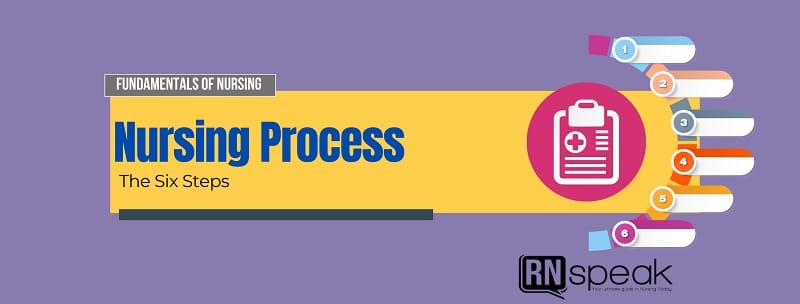The nursing process is a scientific process, which is a foundation, the essential tool, and the enduring skill that has characterized nursing from the beginning of the profession. It has changed and evolved through the years, developing in clarity and scope. It is a plan of care for the patient which may look different from institution to institution but provides both systematic and effective course of intervention to patients.
The 6 steps of Nursing Process
1. Assessment – It is also called data collection. Assessment is both the most basic and the most complex nursing skill, which is at the same time both the initial step in the nursing process and an ongoing component in every other step in the process. In order to assess well, the five senses are being utilized to identify changes in status and in order for the nurse to intervene appropriately.
Data collection is composed of observation of the patient, patient interview, family and support systems, examination of the patient, and the review of medical records. Culture consideration is given an important venue while assessing a patient and one essential skill of assessment is the ability of the nurse to collect only relevant data. In assessment, family relationships, support systems, food preferences, lifestyle habits and activities of daily living, communication styles, and health care beliefs are all included as its aspects.
Frameworks used as guidelines in the assessment are Maslow’s theory of basic needs, Henderson’s components of nursing care, Gordon’s functional health needs, NANDA’s human response patterns, Nursing theories, and human growth and development.
Nursing observations result in objective data. Objective data are factual data that are observed by the nurse. The nurse describes the signs or behaviors observed without drawing conclusions or making interpretations. While data that is consists of information given verbally by the patient is called subjective data. Examples of objective and subjective data are:
Objective data: Tremors of both hands, hair combed, makeup applied, Urinated to approximately 300 cc dark amber urine
Subjective data: “I want to be alone.”, “I feel very nervous about the surgery.”, “This catheter is killing me.”
An interview is a structured form of communication utilized by a nurse to collect data. The use of therapeutic communication like open-ended questions is very beneficial in order to elicit a comprehensive image of the health pattern.
A complete examination of the patient is another integral aspect of the assessment. The body system approach and the cephalocaudal (head-to-toe) approach are mainly used for the examination to be methodical and also to avoid omissions. An examination is composed of visualization, auscultation, percussion, also the five vital signs (temperature, pulse, respiration, blood pressure, and pain.
2. Diagnosis – It is the second step in the nursing process, and it is the phase by which the nurse analyzes the data gathered and identifies the problem for the patient. It is the process of data analysis, problem identification, and the formulation of nursing diagnosis.
A nursing diagnosis is a clinical judgment about the patient’s response to actual or potential health conditions or needs. There are three types of nursing diagnoses: actual, risk, and possible nursing diagnoses. When writing the nursing diagnosis, the nurse usually uses the words “related to,” abbreviated as “r/t”? Examples of diagnosis are:
Actual nursing diagnosis: Impaired skin integrity r/t physical immobilization as manifested by disruption of the skin surface over the elbows and coccyx
At-risk or high-risk nursing diagnosis: Risk for impaired skin integrity r/t physical immobilization in a total body cast, diaphoresis
Possible nursing diagnosis: Possible nutritional deficit (It is an incomplete problem statement since the validity of the problem is uncertain but considered a possibility based on the patient’s response).
3. Outcome Identification – The nurse develops outcomes for the patient to show an optimum or improved level of functioning in the problem areas identified in the nursing diagnoses. It is developed to make the nursing care both individualized for the patient and realistic for the hospital or home care setting. It is composed of setting priorities and establishing outcomes.
The SMART technique, abbreviated as specific, measurable, attainable, realistic, and time-bound, is usually used in making an outcome statement. Meanwhile, an outcome statement is composed of patient behavior, criteria of performance, conditions (if needed), and time frame. Examples of an outcome statement:
- The patient will pass flatus within 24 hours postoperatively.
- The patient’s temperature will be up to 980 F within 1 hour.
4. Planning – The nurse develops a plan of care that prescribes interventions to attain expected outcomes. Nursing interventions are considered activities that are planned and implemented to help patients achieve identified outcomes. Nursing interventions are often given nursing rationale to prove that those interventions are based on principles and knowledge integrated from nursing education and experience as well as from behavioral and physical sciences.
Nursing interventions should be safe for the patient, be congruent with other therapies, realistic, and consider meeting the lower level of survival needs before higher-level needs. It is imperative too that nursing interventions meet the patient’s personal goals and values.
Example:
Nursing diagnosis: Knowledge and skill deficit in taking newborn rectal temperature related to first-time parenting.
Outcome: Take an accurate rectal temperature on her newborn before discharge on 04/17/12.
Nursing interventions:
- Discuss when to take baby’s temperature; signs and symptoms indicating illness.
- Demonstrate how to take a rectal temperature on newborn, 04/16/12
- Explain safety precautions and when to notify physician for fever, 04/16/12
- Provide reinforced practice in taking her newborn’s temperature, 04/16/12
There are several types of nursing interventions. These are the environmental management, independent nursing intervention or the one that is nurse-initiated and ordered intervention, the dependent nursing intervention or nurse-initiated and physician-ordered intervention, and the collaborative intervention or intervention applied with the assistance of other health team members, like a dietician, pharmacist, midwife, and others.
5. Implementation – It is the fifth phase in the nursing process and is consists of validating the care plan, documenting the care plan, giving and documenting the nursing care, and continuing data collection. It is primarily focused on working with the patient and the family to carry out the plan of care.
This is done not only to know how the patient responds to the nursing interventions but also to provide increased information for revising the care plan as the status of the patient changes. The patient is an active participant in care as they are given the right to refuse or request interventions. On the other hand, the nurse is flexible and should be open to suggestions in changing patient and family priorities, but still committed to help promote health, reduce and eliminate, or prevent problems.
6. Evaluation – It should be done continuously while care is being given and as the nurse evaluates progress from intermediate outcomes up to discharge outcomes. Evaluating is composed of documenting responses to interventions, evaluating the effectiveness of interventions, evaluating outcome achievement, and reviewing the nursing care plan.
When deciding how well an outcome was met, there are three alternatives: met, partially met, and not met. When written, an outcome evaluation statement includes if met, partially met, or not met and actual patient behavior as evidence. Example:
Nursing diagnosis: Impaired tissue integrity r/t pressure and poor circulation
Outcome statement: 04/17/09 Decubitus ulcer will be healed in 1 month.
Outcome evaluation statements: (Done on 05/17/09 or earlier)
- Outcome met as evidenced by decubitus ulcer fully healed.
- Outcome partially met, as evidenced by the decubitus ulcer still present but is half in size.
- Outcome not met as evidenced by decubitus ulcer broken and draining.
Review of the nursing care plan is composed of reassessment, review of nursing diagnoses, review of outcomes and replanning, and review of implementation.












